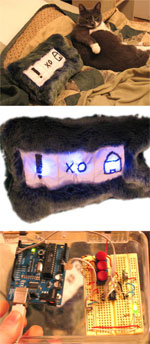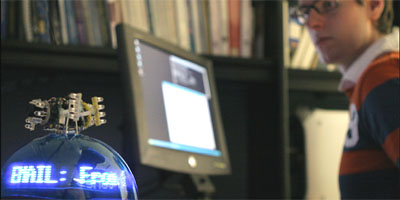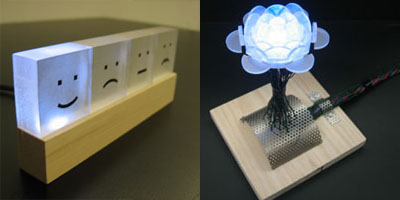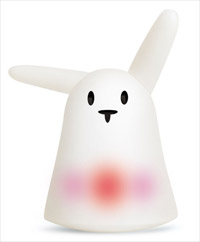Aegis Hyposurface November 9, 2007
Posted by Melissa Quintanilha in ambient displays, innovative displays, innovative interfaces.add a comment

Aegis Hyposurface is an elastic architectural surface made up of small metal plates that are controlled pneumatically and react in real time to electronic stimuli from the environment (movement, sound, light, etc). Driven by 896 pneumatic pistons, the dynamic ‘terrains’ are generated as real-time calculations.
The Aegis Hyposurface effectively links information systems with physical form to produce dynamically variable, tactile ‘informatic’ surfaces. Aegis is perhaps the world’s first such dynamic screen.Any digital input (microphone, keyboard, movement sensor) can trigger any physical output (a wave or pattern or word.)
The Good Night Lamp October 10, 2007
Posted by Melissa Quintanilha in ambient displays, remote communication.1 comment so far

As we move towards a society of single households, our notion of community will change. Keeping in touch with people will gradually become more than being “always on, sometimes off”. We will learn to share parts of our lives with our families, friends and lovers in more subtle ways with the help of an ever sensitive, invisible and intelligent technology.
The Good Night Lamp project is a family of lamps which allow people to communicate the act of coming back home to their loved ones, remotely. As you turn the bigger light on, your presence home is indicated to your friends whose smaller lamps turn on as well. Inversely, the smaller lamps that you’ve collected from your friends will turn on/off as they come home, go out, go to bed. You’ll never come back to an empty home again.
Chatter Pillow October 10, 2007
Posted by Melissa Quintanilha in ambient displays, gadgets, innovative displays, remote communication.add a comment
 Some of the most popular items these days are internet-connected objects that contain glanceable information, such as the status of your inbox, the weather, or stock prices.
Some of the most popular items these days are internet-connected objects that contain glanceable information, such as the status of your inbox, the weather, or stock prices.
The “Chatter Pillow” designed by Rebecca Stern, an undergrad at the Parsons School of Design in New York, is a midterm project for her “Making Wireless Toys” class.
The pillow basically allows Stern to stay on IM from her bed or her couch, without the burden of a laptop — one of the pillow’s trio of icons will light up when one of three possible messages are received, so long as they’re sent only from her boyfriend. If he sends “talk to me,” “xo,” or “on my way,” then the icons (pictured) will glow blue accordingly.
The Unseen Video, a weather controlled, dynamic music video March 30, 2007
Posted by Melissa Quintanilha in ambient displays, music, visualization.7 comments

The Unseen Video is much more than a normal, static music video. It is a video that is affected by the weather and local time from the position of the viewer.
It creates new synergies between the music, the video and the surroundings of the viewer. Every little change in your environment ensures that you will never see the same video twice. The look of the video might slightly change within an hour, but will have a whole new character in a few months.
More information: http://theunseenvideo.com/
Infolight March 10, 2007
Posted by Melissa Quintanilha in ambient displays, gadgets, innovative interfaces, physical interaction design, remote communication.add a comment
 A physical ambient visualization that notifies users of news & information pulled from a personalized online portal using ambient light sequences & sound alerts. The device is equipped with a matrix of 45 LED multicolor pixels, text-to-speech software, movement sensors & WiFi connectivity.
A physical ambient visualization that notifies users of news & information pulled from a personalized online portal using ambient light sequences & sound alerts. The device is equipped with a matrix of 45 LED multicolor pixels, text-to-speech software, movement sensors & WiFi connectivity.
From BT Group
Auraorb ambient notification March 10, 2007
Posted by Melissa Quintanilha in ambient displays, gadgets, innovative interfaces, physical interaction design.add a comment

AuraOrb is an ambient notification display that deploys “progressive turn taking” techniques to minimize notification disruptions. It uses social awareness cues, such as eye contact to detect user interest in an initially ambient light notification. Once detected, it displays a text message with a notification heading visible from 360 degrees. Touching the orb causes the associated message to be displayed on the user’s computer screen. When user interest is lost, AuraOrb automatically reverts back to its idle state.
More information: http://www.nectar-research.net/news/?p=107
Networked ambient objects March 10, 2007
Posted by Melissa Quintanilha in ambient displays, innovative interfaces, physical interaction design, remote communication.add a comment

NYU Interactive Telecommunications Program have been exploring networked ambient visualization devices that allow users to transmit their current mood state to remote friends. Some examples include highlighted emoticons or robotic flowers.
Nabaztag, the Wi-Fi enabled ambient bunny March 3, 2007
Posted by Melissa Quintanilha in ambient displays, gadgets, innovative interfaces, physical interaction design.add a comment
 Nabaztag (Armenian for “rabbit”) is a Wi-Fi enabled rabbit, manufactured by Violet. The Nabaztag is a “smart object” that can connect to the Internet (for example to download weather forecasts, read its owner’s email, etc). It is also fully customizable and programmable.
Nabaztag (Armenian for “rabbit”) is a Wi-Fi enabled rabbit, manufactured by Violet. The Nabaztag is a “smart object” that can connect to the Internet (for example to download weather forecasts, read its owner’s email, etc). It is also fully customizable and programmable.
Nabaztag can send and receive MP3s and messages that are read out loud as well as perform the following services (by either speaking the information out loud or using indicative lights): weather forecast, stock market report, news headlines, alarm clock, e-mail alerts, and others.
Some users join the Rabbit’s community by sharing photos of their Nabaztags on flickr, videos on YouTube and DailyMotion. It is also possible to find other rabbits on Google Earth and check all the posts about Nabaztag over at Technorati.
Learn more and watch some fun demos at: www.nabaztag.com
About ambient displays February 14, 2007
Posted by Melissa Quintanilha in ambient displays.6 comments
Current information interfaces are either interruptive or too detailed. With ambient displays the physical environment becomes an interface to digital information rendered as subtle changes in form, movement, sound, color or light.
For the first time in history, ubiquitous wireless networks can affordably deliver digital information anytime, anywhere. The result for most of us is cacophony. Ambient wants to make the world calmer. Some information requires constant awareness.
For some it’s the status of their portfolio, or the health of an aging parent. Others want to know if their friends are online, the upcoming weather, the score of a game, if the fish are biting, or if there’s heavy traffic on their drive home. These are examples of information that is neither worthy of interrupt (push), nor worthy of investing time (pull). This type of information should be glanceable, like a clock or barometer. This is called ambient information.
Ambient devices elegantly embed digital information into the objects and environments that surround us. These displays are in the form of sound, air pressure, motion, light, smell, and other media that complement the full range of our human sensory modalities. They exist in the periphery of our senses, where they provide continuous information without being distracting.
Source: www.ambientdevices.com
Ambient Orb February 14, 2007
Posted by Melissa Quintanilha in ambient displays, innovative interfaces.add a comment
 The Ambient Orb is a device that slowly transitions between thousands of colors to show changes in the weather, the health of your stock portfolio, or if your boss or friend is on instant messenger. It is a simple wireless object that unobtrusively presents information.
The Ambient Orb is a device that slowly transitions between thousands of colors to show changes in the weather, the health of your stock portfolio, or if your boss or friend is on instant messenger. It is a simple wireless object that unobtrusively presents information.
The Ambient Orb may look like a crystal ball on acid, but it’s really more of a giant mood ring–plugged straight into the fluctuations of the stock market or anything else you care to track. The orb can be wirelessly configured to track any individual stock, any market index or your personal portfolio. “People want information, but they don’t want to invest a lot of time in getting it,” says Ambient president David Rose. “This makes getting information a ‘glanceable’ thing.”
It can be purchased online here for US$150 + shipping.